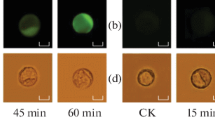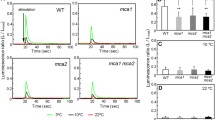Abstract
Salinity (NaCl) and low temperatures significantly affect plant growth, development, and agricultural productivity. Both these stresses trigger an increase in free cytosolic Ca2+ concentration ([Ca2+]i) via Ca2+ influx across the plasma membrane. However, the interaction between salinity- and low temperature-induced [Ca2+]i increases are still poorly understood. We used aequorin to investigate the NaCl- and cold-induced [Ca2+]i signals in Arabidopsis thaliana. We found that the combination of NaCl and cold stimuli induced a greater increase in [Ca2+]i than that by either NaCl or cold separately. Therefore, we showed that these factors had an additive effect on [Ca2+]i increase. Following a pre-treatment of either NaCl or cold, the increase in [Ca2+]i significantly declined in response to a second NaCl treatment or cold exposure. After pre-treatment with NaCl, a subsequent cold stimulus suppressed [Ca2+]i increase to a lesser degree than that by a second NaCl treatment. A similar response was observed after pre-treatment with cold and subsequent treatment with NaCl, but the peak [Ca2+]i differed between them. We propose that NaCl-induced Ca2+ channels differ from those induced by cold and that a feedback mechanism may exist between NaCl- and cold-evoked [Ca2+]i. The Ca2+-permeable channels activated by NaCl were similar to those induced by cold stress; however, they may be expressed in different cells and activated by different signaling pathways. Our results indicated that there is a cross-adaptation in [Ca2+]i changes in response to NaCl- and cold-induced stresses.





Similar content being viewed by others
References
Bailey-Serres J, Mittler R (2006) The roles of reactive oxygen species in plant cells. Plant physiol 141(2):311. https://doi.org/10.1104/pp.104.900191
Berridge MJ, Bootman MD, Roderick HL (2003) Calcium signalling: dynamics, homeostasis and remodelling. Nat Rev Mol Cell Biol 4: 517–529. https://doi.org/10.1038/nrm1155
Cao XQ, Jiang ZH, Yi YY, Yang Y, Ke LP, Pei ZM et al (2017) Biotic and abiotic stresses activate different Ca2+ permeable channels in Arabidopsis. Front Plant Sci. https://doi.org/10.3389/fpls.2017.00083
Clapham DE (2007) Calcium signaling. Cell 131:1047–1058. https://doi.org/10.1016/j.cell.2007.11.028
DeWald DB, Torabinejad J, Jones CA, Shope JC, Cangelosi AR, Thompson JE et al (2001) Rapid accumulation of phosphatidylinositol 4,5-bisphosphate and inositol 1,4,5-trisphosphate correlates with calcium mobilization in salt-stressed Arabidopsis. Plant Physiol 126: 759–769. https://doi.org/10.1104/pp.126.2.759
Dodd AN, Kudla J, Sanders D (2010) The language of calcium signaling. Annu Rev Plant Biol 61:593–620. https://doi.org/10.1146/annurev-arplant-070109-104628
Flowers TJ (2004) Improving crop salt tolerance. J Exp Bot 55: 307–319. https://doi.org/10.1093/jxb/erh003
Galon Y, Nave R, Boyce JM, Nachmias D, Knight MR, Fromm H (2008) Calmodulin-binding transcription activator (CAMTA) 3 mediates biotic defense responses in Arabidopsis. FEBS Lett 582:943–948. https://doi.org/10.1016/j.febslet.2008.02.037
Gilmour SJ, Artus NN, Thomashow MF (1992) cDNA sequence analysis and expression of two cold-regulated genes of Arabidopsis thaliana. Plant Mol Biol 18: 13–21. https://doi.org/10.1007/BF00018452
Hasegawa PM, Bressan RA, Zhu JK, Bohnert HJ (2000) Plant cellular and molecular responses to high salinity. Annu Rev Plant Physiol Plant Mol Biol 51:463–499. https://doi.org/10.1146/annurev.arplant.51.1.463
Hetherington AM, Brownlee C (2004) The generation of Ca(2+) signals in plants. Annu Rev Plant Biol 55:401–427. https://doi.org/10.1146/annurev.arplant.55.031903.141624
Jiang ZH, Zhu S, Ye R, Xue Y, Chen A, An LZ et al (2013) Relationship between NaCl- and H2O2-induced cytosolic Ca2+ increases in response to stress in Arabidopsis. PLoS ONE. https://doi.org/10.1371/journal.pone.0076130
Knight MR, Campbell AK, Smith SM, Trewavas AJ (1991) Transgenic plant aequorin reports the effects of touch and cold-shock and elicitors on cytoplasmic calcium. Nature 352: 524–526. https://doi.org/10.1038/352524a0
Knight H, Trewavas AJ, Knight MR (1996) cold calcium signaling in Arabidopsis involves two cellular pools and a change in calcium signature after acclimation. Plant Cell 8: 489–503. https://doi.org/10.2307/3870327
Knight H, Trewavas AJ, Knight MR (1997) Calcium signalling in Arabidopsis thaliana responding to drought and salinity. Plant J 12:1067–1078. https://doi.org/10.1046/j.1365-313X.1997.12051067.x
Kurusu T, Kuchitsu K, Tada Y (2015) Plant signaling networks involving Ca2+ and Rboh/Nox-mediated ROS production under salinity stress. Front Plant Sci 6: 427. https://doi.org/10.3389/fpls.2015.00427
Leshem Y, Seri L, Levine A (2007) Induction of phosphatidylinositol 3-kinase-mediated endocytosis by salt stress leads to intracellular production of reactive oxygen species and salt tolerance. Plant J 51:185–197. https://doi.org/10.1111/j.1365-313X.2007.03134.x
Luan S (2009) The CBL-CIPK network in plant calcium signaling. Trends Plant Sci 14:37–42. https://doi.org/10.1016/j.tplants.2008.10.005
Ma W, Berkowitz GA (2011) Ca2+ conduction by plant cyclic nucleotide gated channels and associated signaling components in pathogen defense signal transduction cascades. New Phytol 190:566–572. https://doi.org/10.1111/j.1469-8137.2010.03577.x
Ma Y, Dai X, Xu Y, Luo W, Zheng X, Zeng D et al (2015) COLD1 confers chilling tolerance in rice. Cell 160(6):1209–1221. https://doi.org/10.1016/j.cell.2015.01.046
McAinsh MR, Pittman JK (2009) Shaping the calcium signature. New Phytol 181:275–294. https://doi.org/10.1111/j.1469-8137.2008.02682.x
McAinsh MR, Clayton H, Mansfield TA, Hetherington AM (1996) Changes in stomatal behavior and guard cell cytosolic free calcium in response to oxidative stress. Plant Physiol 111:1031–1042. https://doi.org/10.1104/pp.111.4.1031
Meng D, Yu X, Ma L, Hu J, Liang Y, Liu X et al (2017) Transcriptomic response of Chinese yew (Taxus chinensis) to cold stress. Front Plant Sci. https://doi.org/10.3389/fpls.2017.00468
Munns R, Tester M (2008) Mechanisms of salinity tolerance. Annu Rev Plant Biol 59:651–681. https://doi.org/10.1146/annurev.arplant.59.032607.092911
Niu X, Bressan RA, Hasegawa PM, Pardo JM (1995) Ion homeostasis in NaCl stress environments. Plant Physiol 109:735–742. https://doi.org/10.1104/pp.109.3.735
Nordin K, Vahala T, Palva ET (1993) Differential expression of two related, low-temperature-induced genes in Arabidopsis thaliana (L.) Heynh. Plant Mol Biol 21:641–653. https://doi.org/10.1007/BF00014547
Orvar BL, Sangwan V, Omann F, Dhindsa RS (2000) Early steps in cold sensing by plant cells: the role of actin cytoskeleton and membrane fluidity. Plant J 23:785–794. https://doi.org/10.1046/j.1365-313x.2000.00845.x
Pandey GK, Cheong YH, Kim KN, Gran JJ, Li L, Hung W et al (2004) The calcium sensor calcineurin B-like 9 modulates abscisic acid sensitivity and biosynthesis in Arabidopsis. Plant Cell 16:1912–1924. https://doi.org/10.1105/tpc.021311
Park HJ, Kim WY, Yun DJ (2016) A new insight of salt stress signaling in plant. Mol Cells 39:447–459. https://doi.org/10.14348/molcells.2016.0083
Pei ZM, Murata Y, Benning G, Thomine S, Klusener B, Allen GJ et al (2000) Calcium channels activated by hydrogen peroxide mediate abscisic acid signalling in guard cells. Nature 406:731–734. https://doi.org/10.1038/35021067
Qiu QS, Guo Y, Dietrich MA, Schumaker KS, Zhu JK (2002) Regulation of SOS1, a plasma membrane Na+/H+ exchanger in Arabidopsis thaliana, by SOS2 and SOS3. PNAS 99:8436–8441. https://doi.org/10.1073/pnas.122224699
Quintero FJ, Ohta M, Shi H, Zhu JK, Pardo JM (2002) Reconstitution in yeast of the Arabidopsis SOS signaling pathway for Na+ homeostasis. PNAS 99:9061–9066. https://doi.org/10.1073/pnas.132092099
Ranf S, Eschen-Lippold L, Pecher P, Lee J, Scheel D (2011) Interplay between calcium signalling and early signalling elements during defence responses to microbe- or damage-associated molecular patterns. Plant J 68:100–113. https://doi.org/10.1111/j.1365-313X.2011.04671.x
Rengasamy P (2006) World salinization with emphasis on Australia. J Exp Bot 57:1017–1023. https://doi.org/10.1093/jxb/erj108
Smith JM, Salamango DJ, Leslie ME, Collins CA, Heese A (2014) Sensitivity to Flg22 is modulated by ligand-induced degradation and de novo synthesis of the endogenous flagellin-receptor FLAGELLIN-SENSING2. Plant Physiol 164:440–454. https://doi.org/10.1104/pp.113.229179
Spalding EP, Harper JF (2011) The ins and outs of cellular Ca(2+) transport. Curr Opin Plant Biol 14: 715–720. https://doi.org/10.1016/j.pbi.2011.08.001
Stael S, Wurzinger B, Mair A, Mehlmer N, Vothknecht UC, Teige M (2012) Plant organellar calcium signalling: an emerging field. J Exp Bot 63:1525–1542. https://doi.org/10.1093/jxb/err394
Steponkus PL, Uemura M, Joseph RA, Gilmour SJ, Thomashow MF (1998) Mode of action of the COR15a gene on the freezing tolerance of Arabidopsis thaliana. PNAS 95:14570–14575. https://doi.org/10.1073/pnas.95.24.14570
Stockinger EJ, Gilmour SJ, Thomashow MF (1997) Arabidopsis thaliana CBF1 encodes an AP2 domain-containing transcriptional activator that binds to the C-repeat/DRE, a cis-acting DNA regulatory element that stimulates transcription in response to low temperature and water deficit. PNAS 94:1035–1040. https://doi.org/10.1073/pnas.94.3.1035
Swanson SJ, Choi WG, Chanoca A, Gilroy S (2011) In vivo imaging of Ca2+, pH, and reactive oxygen species using fluorescent probes in plants. Annu Rev Plant Biol 62:273–297. https://doi.org/10.1146/annurev-arplant-042110-103832
Tang RH, Han SC, Zheng HL, Cook CW, Choi CS, Woerner TE et al (2007) Coupling diurnal cytosolic Ca2+ oscillations to the CAS-IP3 pathway in Arabidopsis. Science 315:1423–1426. https://doi.org/10.1126/science.1134457
Thomashow MF (1999) Plant cold acclimation: freezing tolerance genes and regulatory mechanisms. Annu Rev Plant Physiol Plant Mol Biol 50:571–599. https://doi.org/10.1146/annurev.arplant.50.1.571
Tracy FE, Gilliham M, Dodd AN, Webb AAR, Tester M (2008) NaCl-induced changes in cytosolic free Ca(2+) in Arabidopsis thaliana are heterogeneous and modified by external ionic composition. Plant Cell Environ 31:1063–1073. https://doi.org/10.1111/j.1365-3040.2008.01817.x
Ward JM, Maser P, Schroeder JI (2009) Plant ion channels: gene families, physiology, and functional genomics analyses. Annu Rev Physiol 71:59–82. https://doi.org/10.1146/annurev.physiol.010908.163204
Webb AAR, Kuchitsu K, Kwak J, Pei ZM, Iida H (2017) Sensors make sense of signaling. Plant Cell Physiol 58(7):1121–1125. https://doi.org/10.1093/pcp/pcx085
Wilkins KA, Matthus E, Swarbreck SM, Davies JM (2016) Calcium-mediated abiotic stress signaling in roots. Front Plant Sci. https://doi.org/10.3389/fpls.2016.01296
Yadav SK (2010) Cold stress tolerance mechanisms in plants. Agron Sustain Dev 30:515–527. https://doi.org/10.1051/agro/2009050
Yamaguchi-Shinozaki K, Shinozaki K (1994) A novel cis-acting element in an Arabidopsis gene is involved in responsiveness to drought, low-temperature, or high-salt stress. Plant Cell 6:251–264. https://doi.org/10.1105/tpc.6.2.251
Yuan F, Yang HM, Xue Y, Kong DD, Ye R, Li CJ et al (2014) OSCA1 mediates osmotic-stress-evoked Ca2+ increases vital for osmosensing in Arabidopsis. Nature 514:367–371. https://doi.org/10.1038/nature13593
Zhu JK (2001) Plant salt tolerance. Trends Plant Sci 6:66–71. https://doi.org/10.1016/S1360-1385(00)01838-0
Zhu JK (2003) Regulation of ion homeostasis under salt stress. Curr Opin Plant Biol 6:441–445. https://doi.org/10.1016/S1369-5266(03)00085-2
Zhu JK (2016) Abiotic stress signaling and responses in plants. Cell 6:313–324. https://doi.org/10.1016/j.cell.2016.08.029
Zhu X, Feng Y, Liang G, Liu N, Zhu JK (2013) Aequorin-based luminescence imaging reveals stimulus- and tissue-specific Ca2+ dynamics in Arabidopsis plants. Mol Plant 6:444–455. https://doi.org/10.1093/mp/sst013
Acknowledgements
The authors thank M. R. Knight for providing aequorin-expressing Arabidopsis seeds and Prof. Zhenming Pei for valuable advice and support regarding the experiment. This work is financially supported by grants from the National Natural Science Foundation of China (No. 31400229) and by the public welfare projects of Zhejiang Province (No. 2014C32121). This work was also supported by the Zhejiang Province Public Welfare Technology Application Research Project (LGN18C020005).
Author information
Authors and Affiliations
Contributions
XL and YT designed the experiments. CW, YT, LZ performed them. SZ, CW, XL analyzed the data. SZ, YT provided the reagents, apparatus, and analytical tools. All authors listed approved it for publication. YT and SZ reviewed the article, XL wrote the manuscript.
Corresponding author
Electronic supplementary material
Below is the link to the electronic supplementary material.

10725_2018_464_MOESM1_ESM.jpg
Supplementary material 1. Fig. S1 Increases in [Ca2+]i in response to NaCl and cold treatments. Effect of EGTA, LiCl and LaCl3 on NaCl or cold-triggered [Ca2+]i increases. (A and C) Arabidopsis thaliana seedlings were pre-incubated for 1 h in water (Control), 1 h in 20 mM EGTA, 30 min in 20 mM LiCl, and 1 h in 10 mM LaCl3 before the NaCl (A) and cold (C) treatments. The seedlings were then subjected either to 200 mM NaCl or 13.5°C cold. Aequorin luminescence was recorded. (B and D) Quantification of [Ca2+]i increase from experiments as in A and C, respectively. Data for three independent experiments are shown (mean ± SD; n = 64; NS, not significant P > 0.05) (JPG 1225 KB)

10725_2018_464_MOESM2_ESM.jpg
Supplementary material 2. Fig. S2 H2O2 levels do not affect [Ca2+]i increase in response to NaCl or cold treatment. (A and C) Arabidopsis thaliana seedlings were treated with water (Control), 15 µM of the NADPH oxidase inhibitor DPI, and 5 mM of the ROS scavenger glutathione 2 h prior to the NaCl (A) and 13.5°C cold (C) treatments. The seedlings were then subjected either to 200 mM NaCl or 13.5°C cold. Aequorin luminescence was recorded continuously in the dark for all treatments. (B and D) Quantification of peak [Ca2+]i increase. Data for three independent experiments are shown (mean ± SD; n = 64; * P < 0.05) (JPG 1168 KB)
Rights and permissions
About this article
Cite this article
Wang, C., Teng, Y., Zhu, S. et al. NaCl- and cold-induced stress activate different Ca2+-permeable channels in Arabidopsis thaliana. Plant Growth Regul 87, 217–225 (2019). https://doi.org/10.1007/s10725-018-0464-7
Received:
Accepted:
Published:
Issue Date:
DOI: https://doi.org/10.1007/s10725-018-0464-7




